Foreign Insulators
by Marilyn Albers
Reprinted from "Crown Jewels of the Wire", January 1987, page 23
A JAMAICAN CHRISTMAS TREE
Several weeks ago, Carol McDougald wrote to me regarding some correspondence
she had with a collector who lives in Jamaica. This fellow had sent photos to
her along with some background information on a glass "insulator"
reportedly used on that island many years ago. An "Old Gentleman"
friend of his remembers seeing these same insulators mounted on telegraph poles
there when he first came to Jamaica around 1920. He said that a wooden dowel,
which went all the way to the top of the pin hole, held the insulator in place
on the cross arm. He even identified two modern styles of threaded glass
insulators, used for the same purpose, which had replaced the earlier version
you see in the photos below.
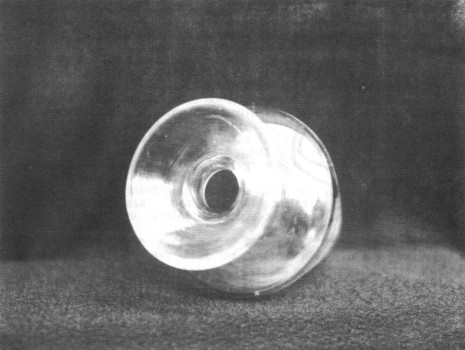
The insulator is hand blown of straw colored flint glass. It measures 3-1/4" across the base, 4" at its widest point and stands 6-5/8"
tall. There are no markings on it at all. The glass is actually quite thin
(1/8") throughout most of the crown portion, making it a very fragile
piece. Doesn't it remind you of a small glass Christmas tree? This particular
piece came from auctioned items which belonged to the Jamaican
Agricultural/Livestock Society, which controlled the telecommunication system in
Jamaica at that time.
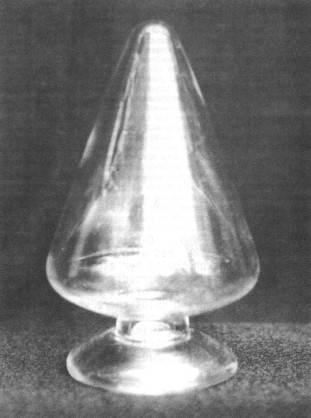
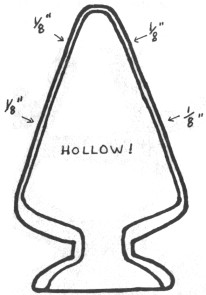
Carol asked me what I thought of all this. Had I ever heard of this insulator
before or seen one? Was it even an insulator? She asked the Jamaican collector
to send her one of the glass pieces, which she then mailed to me. It arrived
just in time to catch the monthly meeting of our LONE STAR INSULATOR CLUB, and
Mr. N. R. Woodward and several other members were able to see it.
We have to
admit that this is definitely a new one to us! And it is a beautiful thing. What
bothered most of us, though, was the very thin glass. Would this have been
practical? With the lack of threads and such a short neck to hold any sort of
pin in place, how could it be very stable? Was it meant to have other parts,
perhaps of metal, which are missing? If so, was it intended for use as a
lightning arrestor? Or to be used simply as an ornament, and why?
The shape of this piece reminds one of the wooden finials used as decoration
on top of British telegraph poles. Also, the general appearance of the glass is
very much like that of CD 435, an unmarked "Post Office" insulator
that was recovered from the London, Midland & Scottish Railway (L.M.S.) in
England. There are only two know specimens of this "oldie" still in
existence. It is pictured on page 53 of Keith Neal's book, "SEARCHING FOR
RAILWAY TELEGRAPH INSULATORS." Were these two, the Jamaican insulator and
CD 435 made by the same glass factory? In England?
Knowing that the Island of Jamaica is a member of the British Commonwealth
and that British insulators could very well have found their way to Jamaica, I
decided to consult with Keith Neal. I sent him a letter with the photos and all
the information I had about the piece. Let me share with you his reply:
"I can give you no real help over the weird glass insulator as I have
ever in my life set eyes on such a thing, and my first glance said to me
"NO," this cannot be a telegraph insulator to go on an arm unless it
was purely ornamental as a finial. But being such thin glass, this makes no
sense! Even if it is part of an insulator which had a metal covering, there is
no indication. However, the fact that it takes a normal wooden spindle rather
upsets my instinct that it is not a telegraph insulator. So all I can say is,
once more, I have never seen anything like it used as an insulator. It could
have been designed by someone who had never heard of stone throwing! Because it
is so thin and fragile, it is rejected even as a finial. I think I must conclude
it is a genuine "what is it" and has some value as such. It is a good
conversation piece. Enough said!"
Mr. Woodward said essentially the same thing and so, with all this good
counsel, I rest my case! Thanks for all your help, Keith and Woody, and thanks
go to Carol for letting us know about this one!
(EDITOR'S NOTE: Both Marilyn and I would appreciate any facts or reactions
you readers have about the Jamaican piece before I return it to its owner.)
NEW ADDITIONS TO THE CONSOLIDATED DESIGN (CD) CHART
I'd like to show you three insulators that have come into the spotlight
recently, thanks to the trust of the collectors who own them and let me take the
pieces home with me top get shadow drawings and measurements.
In the first photo below, let me introduce CD 209, a beauty in straw colored
glass from Chile. It is embossed CRISTALERIAS DE CHILE - N. 42. The glass
manufacturer of that name is located in Santiago. The insulator belongs to Joe
Maurath, Jr., who sent it to me by mail.
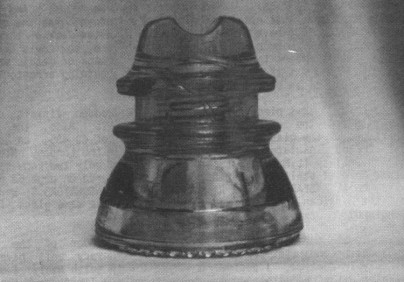
The second photo shows our new CD 677.3, the smallest of the three known
sizes of Italian "T-Bars," as they are affectionately dubbed. This one
is only 2-1/2" across the base, has an arm spread of 3-7/8" and stands
a mere 3-1/8" tall. It is embossed MIVA/BT 3M. This little one in pale blue
came home with me from the Bakersfield Show last October, courtesy of Norm
James.
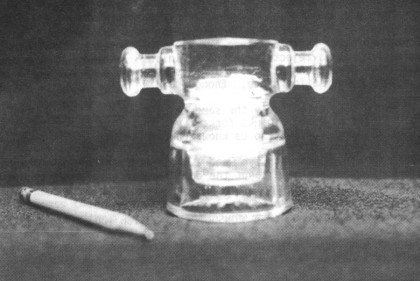
The last photo is a really pretty piece of aqua glass owned by Mike Guthrie.
He, too, is a good egg and watched me disappear around the corner with his
little Belgian insulator, CD 565 VERLICA BELGIUM/BT 10. Mike also loaned me
several foreign porcelains, but I will wait until Jack Tod and I can consult for
new U-numbers, and then I'll show them to you. However, the next time my column
is run, you will see two glass insulators you will not believe! I didn't! One is
from the Island of Majorca and other comes from Portugal. So stay tuned! These
are new ones to collectors!
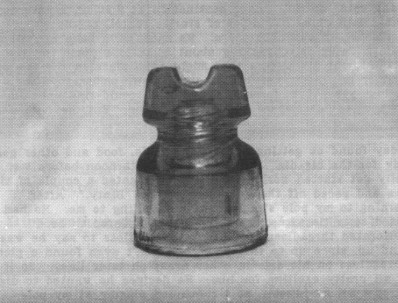
| 